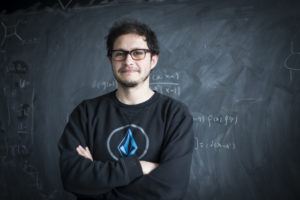The Neural Network: How artificial intelligence is fuelling “Phasebook”
New research by Perimeter scientists employs artificial intelligence techniques to explore phases of matter.
Take a self-guided tour from quantum to cosmos!
New research by Perimeter scientists employs artificial intelligence techniques to explore phases of matter.

A machine learning algorithm designed to teach computers how to recognize photos, speech patterns, and hand-written digits has now been applied to a vastly different set a data: identifying different phases of condensed matter.
In a project half-jokingly called “Phasebook,” two Perimeter researchers showed that a neural network system – a standard part of today’s powerful artificial intelligence (AI) algorithms – can also identify phase transitions between states of matter. The research, published today in the journal Nature Physics, validates the idea that the relationship between theoretical physics and AI can be a fruitful, two-way exchange.
The fields have long been linked. AI research has often tapped physicists to help develop machine learning for industry. Now, former Perimeter postdoctoral fellow Juan Carrasquilla and Roger Melko, an Associate Faculty member at Perimeter and Associate Professor at the University of Waterloo, have turned the tables by posing a fairly straightforward question: could industry-standard AI help fuel physics research?
To find out, Carrasquilla and Melko repurposed Google’s TensorFlow, an open-source software library for machine learning, and applied it to a physical system.
The same algorithm helps computers read hand-written digits such as those on postal envelopes or bank cheques, powers facial recognition capabilities and natural language processing and translation, and famously was used to beat the human world champion in the ancient game of Go.
“Instead of recognizing hand-written digits, we took the same neural network and put in images our computers produced of different phases,” says Melko, who holds the Canada Research Chair (Tier 2) in Computational Quantum Many-Body Physics and won the 2016 Herzberg Medal from the Canadian Association of Physicists.

The neural network distinguished phases of a simple magnet, and could distinguish an ordered ferromagnetic phase from a disordered high-temperature phase. It could even find the boundary, or phase transition, between phases, says Carrasquilla, who now works at quantum computing company D-Wave Systems.
“We inspected the neural network and found out it learns to read the magnetization of the images, [which is] the theoretical concept used to quantify the degree of order in simple magnets,” he explains.
The results open up new pathways for condensed matter research and statistical physics. The work – published as a preprint on the arXiv in May, 2016 – has already been cited in a diverse mix of papers that run the gamut from quantum entanglement to DNA research.
Some papers have taken the general idea and applied it in different areas; others have similarly tapped TensorFlow as a research tool. Melko himself is among the researchers searching for new applications for machine learning in physics.
He and Jeff Chen, a colleague at the University of Waterloo and also an Affiliate Member at Perimeter, used TensorFlow to study when and how polymers fold – research (to be published) that links into perplexing questions in the study of proteins and DNA.
None of this was assumed when Carrasquilla and Melko first toyed with the idea of repurposing TensorFlow. “I explored some online machine learning courses and found them so inspiring,” Carrasquilla says. “I wanted to bring those ideas and apply them to condensed matter problems. Neural networks sounded like the best bet since they reminded me of the wave functions we deal with in many-body physics.”
Melko says they didn’t know what to expect. “I thought it was a long shot,” he admits.
The thing about neural networks is that they only work if you have enough raw data. You need millions of cat photos in order to teach a computer how to tell a Siamese from a Sharpei. Without enough data, the software can’t learn.
Luckily, physicists at Perimeter and elsewhere have mountains of digital data, built up over decades of simulations on supercomputers and in experimental observations. Carrasquilla and Melko used decades-worth of images of different phase states created using simulation software on supercomputers at the University of Waterloo. They introduced the data, and waited. Could the software be trained to recognize phases instead of felines? It turns out, it could.
“Once we saw that they worked, then we knew they were going to work for everything. All of a sudden, the sky’s the limit,” Melko says. “Everyone like me who has access to massive amounts of data can try these standard neural networks.”
This is just one part of an explosion of interest in machine learning, which is predicted to impact everything from big banks to transit planning. For Melko, who organized the first “Quantum Machine Learning” conference at Perimeter in 2016, there is a deeper question to address. He wants to understand how a neural network consisting of a couple of megabytes can represent a quantum wave function that requires gigabytes to simulate.
“It’s a representation question: why is a neural network so powerful that it can efficiently and compactly represent a quantum wave function? That’s a big open question.”
Watch: Juan Carrasquilla’s talk about machine learning phases of matter, from the 2016 Quantum Machine Learning conference.
Read more: Roger Melko explains what drew him to machine learning, and how it could transform condensed matter research.
Read more: Roger Melko writes about the value of smart machines for Quartz.
Perimeter researchers looking deep into simulations of quantum computers have found something startling: new physics. Specifically, they found a new kind of phase transition, and a new tool for exploring dynamical phases of matter.
With the launch of a new collaboration lab, physicists are adding fuel to the AI revolution, writes Perimeter Associate Faculty member Roger Melko.
Long seen as the domain of computer scientists, machine learning is now considered a powerful tool for tackling difficult problems in quantum physics.